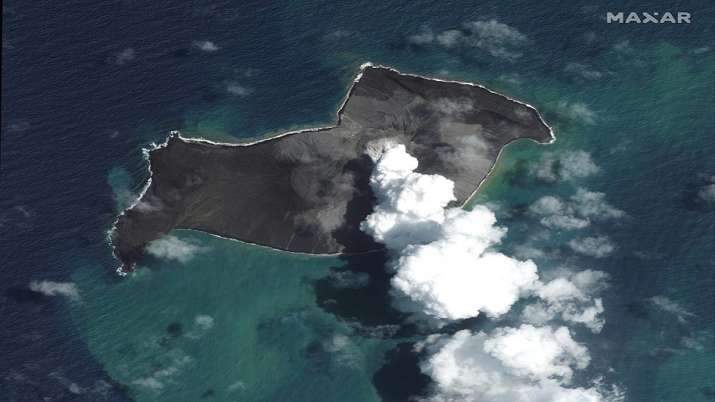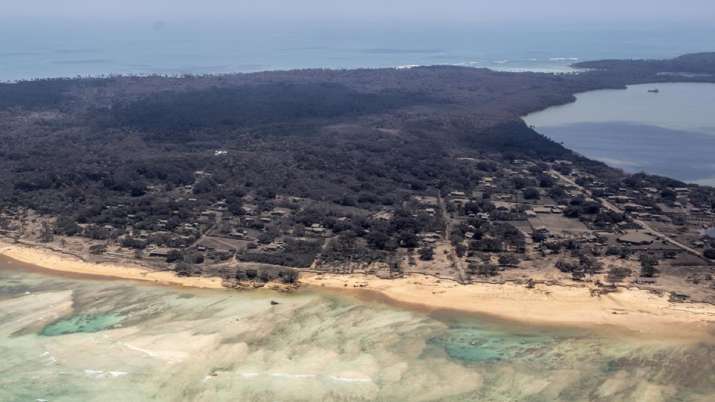
This satellite image provided by Maxar Technologies shows an overview of Hunga Tonga Hunga Haapai Volcano in Tonga prior to a massive underwater volcanic eruption.
Highlight
- The eruption on 15 January was incredibly explosive, but was also relatively brief in Tonga.
- The plume rose more than 30 km into the air but the eruption only lasted 10 minutes
- The magma inside the volcano was under tremendous pressure and trapped gases
People around the world watched in awe at spectacular satellite images of an underwater volcano erupting in a giant mushroom cloud in the Pacific Ocean. Many wondered why the eruption was so big, how the resulting tsunami traveled so far, and what would happen next. New Zealand scientist Shane Cronin, professor of volcanology at the University of Auckland, and Emily Lane, a tsunami expert at the National Institute of Water and Atmospheric Research, help explain.
explosive but brief
Saturday’s eruption was incredibly explosive, but also relatively brief. The plume rose more than 30 kilometers (19 mi) into the air, but the eruption only lasted about 10 minutes, unlike some larger eruptions that can continue for hours. Cronin said the power of the eruption of Hunga Tonga Hunga Ha’apai volcano is one of the world’s largest in the past 30 years, and the height of the ash, steam and gas plumes was comparable to the massive 1991 eruption of Mount Pinatubo. Philippines, in which several hundred people were killed.
Read also: Tonga volcano eruption, tsunami: scale of damage emerges, ash delays aid
Why so big?
The magma inside the volcano was under tremendous pressure and trapped gases. A fracture in the rock induced a sudden drop in pressure, causing the gas to expand and the magma to separate. Cronin theorized that the crater sat about 200 meters (650 ft) below the ocean surface, a type of Goldilocks depth leading to a major eruption in which seawater poured into the volcano and immediately turned to steam, accelerating the eruption. Increases expansion and energy. , Any deeper and additional pressure from the water would have helped stop the explosion.
farflung tsunami
Many scientists were surprised that a single eruption could generate a Pacific-wide tsunami of about 1 m (3 ft) that wrecked boats in New Zealand and caused an oil spill and two drownings in Peru. Lane said that ocean tsunamis usually result from earthquakes that span vast areas, essentially a small point in the ocean, rather than a volcano. She said other factors may be at play, such as the underwater edge of the volcano collapsing and displacing water. She said an interesting theory is that a shock wave, or sonic boom, from a volcano traveling twice around the world may have pumped more power into the tsunami waves.
Tonga mainly spared
Another mystery is why the tsunami was not bigger and more destructive in Tonga, which sits almost on top of a volcano.
“It’s the million dollar question,” Cronin said. “Looking at the images so far, the level of devastation is less than I fear.”
Authorities had confirmed three deaths in Tonga as of Wednesday, raising concerns about people on some of the hardest-hit small islands. Dozens of houses were destroyed.
Lane said Tongans received at least some warning, both from increased activity at the volcano the day before the eruption and from the incredibly loud blaze when it erupted, but before the tsunami hit, many people were evacuated to higher ground. Scramble was allowed. She said reefs, lagoons and other natural features could also be protected parts of Tonga, while waves could be amplified in some areas.
falling hopes
Cronin said the ash in which Tonga is coated is acidic but not poisonous. In fact, he has been advising Pacific responders that people may still be able to drink from their rainwater supply, even if some of the ash has fallen, making the water more acidic and salty. He said it was a question of applying the taste test and that if the water was reduced, it would be better to drink ash-rich water than contaminated water that could be contaminated with bacteria. New Zealand and other countries are trying to get water and other supplies to Tonga as soon as possible. Cronin said all of Tonga’s soil comes from volcanic ash and that the latest dump of ash would quickly wash into the ground and make the country more fertile.
no global cooling
Giant volcanic eruptions can sometimes cause temporary global cooling as sulfur dioxide is pumped into the stratosphere. But in the case of the Tonga eruption, initial satellite measurements indicated that the amount of sulfur dioxide released would only have a small effect of cooling the 0.01 °C (0.02 Fahrenheit) global average, said Rutgers University professor Alan Roecock.
what will happen next
Cronin envisions two main scenarios for the volcano. The first is that it has dissipated for now and will cool for the next 10 to 20 years as the magma slowly recedes. A second scenario is that new magma rises rapidly, which erupts, in which case an eruption may be underway. But he believes that the cracks and crevices caused by Saturday’s large eruption will allow more gas to escape, and subsequent eruptions will not be as large, at least for now. Both Cronin and Lane agree that better monitoring of volcanoes and others in Tonga is needed to help better predict future events.
Read also: Tremors of Tonga volcano eruption were also felt in India
,
